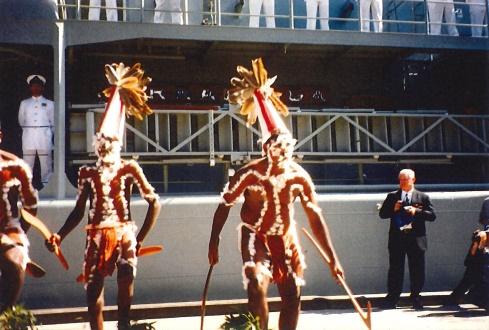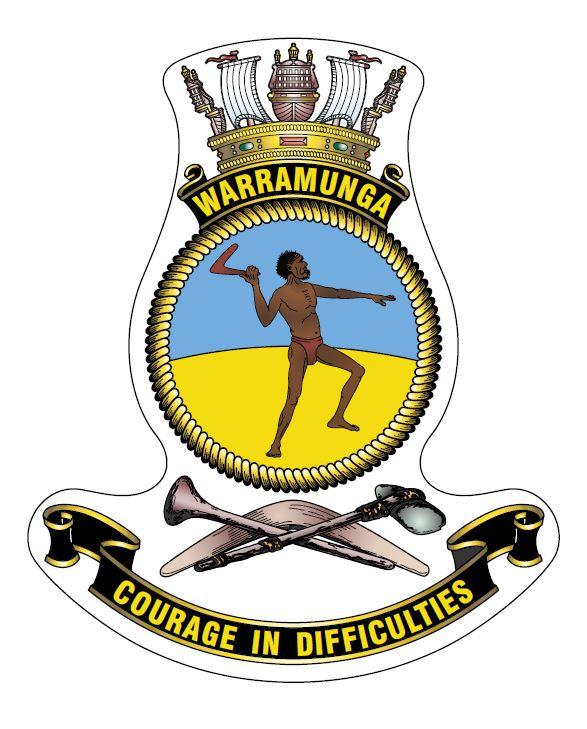The history of HMAS Warramunga
The Anzac class frigate HMAS Warramunga (II) was launched in 1998, more than 50 years after the original HMAS Warramunga (I) set sail during the Second World War.

Waramungu men Darius Plummer, Cameron Plummer, and E. Kumantjayi Plummer perform a peace and welcoming dance at the launch of HMAS Warramunga in Melbourne, 1998. The men also performed a fighting dance, to give the ship and crew strength and wisdom to overcome enemies.[1] (Jacqueline Hingston Namikili , photo courtesy of the Waramungu tribe).
The original HMAS Warramunga was named after the Warumunga tribe, located in the Tennant Creek area of the Northern Territory between Alice Springs and Katherine. In the early 1900s, the Warumungu people had experienced much hardship as a result of frontier conflict. Gold was discovered in the region in the 1930s, setting off Australia’s last great gold rush.[2] Prospectors arrived, and by the 1960s the Warumungu people had been pushed off their land.
In 1978, the Central Land Council tried to reclaim the land back on behalf of the Warumungu people, under the Aboriginal Land Rights Act.[3] It was not until 1992 that title to 3,090 square kilometres of traditional lands was finally granted.[4]
Author Ernestine Hill described the Warumunga people as merry, song makers, the masters of music and mysticism, famous for fire ceremonies and corrobborees, and the most imaginative tribe in Australia.[5]
During the Second World War, it was decided that three new Australian tribal class destroyers would be named after Aboriginal nations, one of which was HMAS Warramunga (I).
Commander Emile Dechaineux held a competition for his crew to come up with a badge and motto to represent the ship. Petty Officer Hugh Anderson’s image of a Warumungu man about to throw a boomerang won the design. Able Seaman Arthur Paul created the winning motto, “courage in difficulties”. The men received a dozen bottles of beer as their prize.[6]

The badge and motto of HMAS Warramunga, with the blue and yellow background representing the sky and desert. The badge shows a wunjaana (war axe), gudruu (fighting club), and kyyin (man killer boomerang). Image courtesy of the Royal Australian Navy.
HMAS Warramunga (I) operated in the Pacific theatre of war, in areas including New Guinea and the Philippines. When the Second World War ended, the ship transported Allied prisoners of war and internees from Japan to their homelands. Warramunga (I) went on to serve in the Korean War, before participating in operations and exercises throughout south-east Asia. She was sold to a Japanese company for breaking up (demolition) in 1963.
HMAS Warramunga (II) now proudly sails under the original badge and motto. It honours the first Warramunga, but also the Warumungu people and their life of courage in harsh environments. [7]
Footnotes
[1] Correspondence with Paul Hingston, 2019.
[2] Barkly Tourism, History of Tennant Creek, <accessed 22 October 2019>.
[3] Central Land Council, The Warumungu Land Claim, August 1994 <accessed 8 October 2019>.
[4] HMAS Warramunga Veterans’ Association, The Warramunga Story, p. 69
[5] HMAS Warramunga Veterans’ Association, The Warramunga Story, pp. 63-64
[6] HMAS Warramunga Veterans’ Association, The Warramunga Story, p. 47
[7] Royal Australian Navy, HMAS Warramunga (II), <accessed 8 October 2019>.
